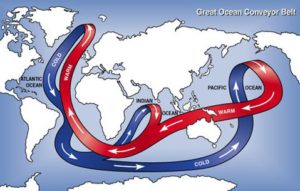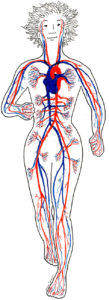An Illustration: The Synergy of Our Outer and Inner Oceans in Balance
Not many people realize just how much we have in common with the ocean. Having studied paleoceanography in grad school–a fascinating subject–I now know more about ocean currents than I ever imagined I would! What I find most extraordinary about large-scale planetary processes, is just how similar their characteristics are to our own bodies.
By the way, did you know your body has an inner ocean?—Your blood! The ocean, along with our blood, feeds us and cleans us. Not only that, ocean and blood deliver fresh oxygen and other nutrients to the planet and all 100 trillion cells of the body, while flushing out carbon dioxide, ammonia and other metabolic trash. Ocean, blood and bodies can also find balance in similar ways. My goal in the following science-y illustration is to explain why taking care of your body allows you to be more receptive to taking care of your ocean environs.
Plasma & Seawater
The planet is covered by 70% ocean. Similarly, our bodies are about 60% water. The watery portion of blood–the plasma, our inner ocean–has a concentration of salt and other ions that is remarkably similar to sea water. Given our mammalian lineage evolved from tetrapods, which crawled out of saltwater some 400 million years ago, it’s not surprising salt is the only mineral that we intentionally ingest.
Cardiovascular Circulation & Thermohaline Circulation
Envision your heart pumping blood, oxygen, heat and nutrients throughout the body the same way thermohaline circulation (THC) and deep-ocean upwelling can pump and circulate nutrients, heat and currents throughout the entire planet. Your heart helps control bodily thermoregulation just as the ocean controls and buffers climatic systems on the planet. (I’ll explain these big terms later).
Organs like Ocean
Coastal marshes (or wetlands) filter out toxins and waste products in a similar way our liver and kidneys remove toxins and waste products from our blood. Think of the abundance of tiny ocean plant organisms (phytoplankton) diffusing O2 into the atmosphere the same way our lungs diffuse O2 into red blood cells after inhalation. As you….BREEEEAAATHE….slowly, in and then out. Imagine waves crawling up the sandy shore then back down.
Similar Signs of Disturbance and Balance
Both body and planet have thresholds for disturbance. We can measure the health of our body and we can measure the health of the ocean. Both are very resilient to disturbances, but certainly not devoid of death. The ocean is NOT too big too fail. The ocean gives us signals when it is out of balance or failing, the same way our bodies do.
In illustration, let us take a closer look at thermohaline circulation (THC), also known as the Great Atlantic Conveyor Belt, located south of Greenland. THC is driven by northern moving, warm, low density gradient water created by surface heat and freshwater fluxes. THC is known to “switch off” when there is immense freshwater influx (i.e. from quickly melting ice caps). When this happens, it severely affects the climate of the Northern Hemisphere. Likewise, the human heart is also known to “switch off” when severely disrupted. When the heart stops pumping blood, it’s fatal. When the ocean stops upwelling or pumping the conveyor belt, marine life and weather patterns are severely disrupted.


Another signal of disturbance is loss of vitality. Too much of anything, including nutrients, can be fatal to animal bodies and bodies of water. As humans, if we overdose on toxins, drugs or food, our bodies lose vitality, or perish. In the ocean, nutrients such as nitrogen and phosphorus are essential elements for plant growth. However, if they are overabundant in a body of water, for example, resulting from excess agricultural run-off, the resulting concentrated nutrients can stimulate an overgrowth of algal blooms, which depletes the supply of oxygen in the ocean, resulting in hypoxic dead zones. Most of the marine species that live in these areas either die or, if they are mobile (such as fish), leave the area. Habitats that would normally be teeming with life become, essentially, biological deserts. At present, vast swaths of ocean are becoming dead zones.
The Take Home
The health of the human body (better yet, humanity at large) and the health of the ocean are synchronous. Ocean and human life are interdependent systems, except only that we couldn’t survive without the ocean. The ocean is our life support system. Collective mindfulness protects the balance of the ocean from our impact. Therefore, next time you do something good for your body, consider it as also doing something good for the ocean!